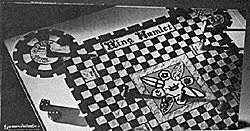
Designed by John A. Anderson
Gamevenings 409 East 48th Street New York, NY 10028
Release Date: 1981
Price: $14,00
Complexity: Intermediate
Solitaire Suitability:
None
Rating: ****
Just when you thought you'd left the Bard behind forever in Miss Fishbein's senior English class, a game appears on the market called King Hamlet. But guess what? It's fun and requires no knowledge of Shakespeare to play. So why the title? Quite simply, the game is "freely based on Shakespeare's tragedy." In other words, if you've read Hamlet, the names Hamlet, Ophelia, and Horatio will be familiar to you. if you haven't, your enjoyment of the game is not impeded.
King Hamlet allows 2 to 8 players the opportunity to visit various characters in hopes of learning ten "secrets," These secrets are the letters which spell out KING HAMLET. The first player to discover all ten secrets declares himself King Hamlet and wins the game.
The board, representing the floor of the Castle Elsinore, is essentially a checkerboard. There is a central starting place for all of the playing pieces. At each corner are the major characters: the Ghost, the Queen, Horatio, and Ophelia. Minor characters like the courtiers, and the players are located elsewhere on the board. Finally, there are six assassins lairs; labeled as Ophelia's garden, Horatio's study etc. Scattered among these locations are the "secrets" each player seeks in his quest to become "king."
A player's journey is marked by two pawnshaped playing pieces of the same color; the larger one is the prince, the smaller the knight. The moves of these two men are determined by a roll of the dice.
At the beginning of the game, players choose their "colors" and place their two men on the appropriate shield in the center of the board, The secrets--36 tiles with various letters--are distributed face down, to the various characters and lairs on the board. Each player keeps one tile which is his princes secret. in addition, each player places an assassin in one of the lairs. The location of his assassin is recorded by each player on his score sheet, but is kept secret until someone enters that lair.
The players begin their visits to each character, moving horizontally, vertically, or diagonally A player may move either his prince or knight on any throw of the dice. True to medieval tradition, a prince has certain privileges; for example, only princes may visit the Ghost. Furthermore, if a knight is killed the prince can still function. if, however, a player loses his prince, he is out of the game.
When a player visits a character by landing on the square bearing that character's name the player learns all of his secrets. To learn the secrets, the player turns over the tiles located at the spot, records the letters on his scoresheet, and replaces the tiles for other players. Although there are duplicates of most letters, including 11 Es, there is only one K and one H. Therefore, it is possible for a player to visit all major and minor characters without recovering the elusive K or H. He must then start venturing into assassin's lairs. if the lairs are inhabited, he loses his knight or prince who entered those lairs. The missing letter could even turn out to be a prince's secret. In that case, the player must risk a duel of the dice to learn that secret.
If all this sounds complicated, it is. And that is the chief flaw of the game. it comes with 12 pages of rules. Although the game is listed for ages 8 to adult, I've yet to meet an 8- year-old who could easily master the rules. In fact, the first two times through the game, the rule book never left my hand. I was constantly checking some detail.
Strangely enough though, this almost guarantees replay of the game. You virtually have to play it once to get the hang of it, twice to check your details, and only by the third time will you begin to plot any strategy. By that time you're hooked. The game moves quickly The results vary according to the number of players involved and the random placement of the secrets. in short, blind luck can foil ploys of skill.
King Hamlet is beautifully packaged and eyecatching. The rules are complex, even including extra variations for the more experienced player. In essence, it is a typical board game with a medieval flavor-kind of like "Dungeon Master buys Park Place," But it's fun; more fun with each successive time I've played. King Hamlet does Shakespearean characters proud.
More Reviews
-
Game Review: RuneQuest
Game Review: Star Trek: The Role Playing Game
Game Review: Toon
Game Review: Battle Above the Earth
Game Review: Paranoia
Game Review: Tsathogghua
Game Review: South Mountain (ACW)
Game Review: Shiloh (ACW)
Game Review: Third World War
Game Review: Boots and Saddles ('80s Air Cav)
Game Review: Axis and Allies (WWII)
Game Review: 8th Army: Operation Crusader
Game Review: James Clavell's Shogun
Game Review: King Hamlet
Game Review: Grass
Game Review: Hack 'N' Slash
Back to Table of Contents -- Game News #1
To Game News List of Issues
To MagWeb Master Magazine List
© Copyright 1999 by Dana Lombardy.
This article appears in MagWeb (Magazine Web) on the Internet World Wide Web.
Other military history articles and gaming articles are available at http://www.magweb.com